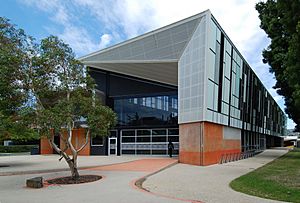LEED facts for kids
Leadership in Energy and Environmental Design (LEED) is a special program that gives a "green" stamp of approval to buildings. It helps make sure buildings are designed, built, and run in ways that are good for the environment. This program started in 2002 and is known all over the world.
LEED helps people create buildings that save energy, water, and other resources. It also makes sure the indoor air quality is good. Buildings can earn points in different areas like how they use land, save water, use energy, choose materials, and keep the inside air clean. There are 100 main points available, plus extra points for new ideas and local needs.
LEED is not just a set of rules; it's a way to plan and build projects that last a long time and are kind to our planet. It only applies to buildings, not to products like your phone or clothes. It's not a prize you win, but a certification given by groups like the Canada Green Building Council (CaGBC). They check to make sure all the rules are followed.
Using LEED helps save money in the long run, keeps people healthier, and reduces pollution on Earth. For example, if you build a house, LEED suggests keeping the excavated dirt on the site instead of sending it to a landfill. If you tear down an old building, you should recycle as many materials as possible. You should also try to use old materials in the new building.
Contents
LEED Certification Levels
Buildings can get different levels of LEED certification based on how many points they earn. The more points, the "greener" the building!
| Certification Level | Points Needed |
|---|---|
| Certified | 40–49 points |
| Silver | 50–59 points |
| Gold | 60–79 points |
| Platinum | 80 points and above |
The highest level is Platinum, which means the building is super green and environmentally friendly.
Benefits and Challenges of LEED Buildings
Building a LEED-certified project has many good points, but also some challenges.
Initial Costs
One of the biggest challenges is the cost at the very beginning. Making a building super green can seem expensive at first. You might need special materials or designs.
Long-Term Savings
However, if you think about it as a long-term investment, a LEED project can actually save a lot of money over time. Green buildings often use less energy and water. This means lower utility bills every month.
For example, a study in 2008 looked at LEED-certified buildings. It found that most of them saved money on their running costs. These savings could be quite large, ranging from about $5 to $15 for every square foot of floor space. This shows that green buildings are often cheaper to operate in the long run.
Images for kids
-
Washington, D.C., is the first LEED Platinum city in the world. Pictured is 1225 Connecticut Avenue, the first redeveloped office building on the U.S. East Coast to receive LEED Platinum status.
-
Arlington County, Virginia, is the first LEED Platinum community in the world. Pictured is 1812 N Moore, the tallest LEED Platinum building in the Washington metropolitan area, and other towers of various LEED status.
-
Phipps Conservatory & Botanical Gardens in Pittsburgh has multiple LEED certifications, including the world's only Platinum-certified greenhouse and a Platinum-certified and net-zero energy Center for Sustainable Landscapes.
-
The University of Texas at Dallas Student Services Building is the first academic building in Texas to receive LEED Platinum status.
-
Shearer's Foods plant in Massillon, Ohio, is the first food manufacturing plant to receive LEED Platinum status.
-
Shanghai Tower, the tallest and largest LEED Platinum certified building in the world since 2015.
-
The Empire State Building in New York City is one of the tallest and most well-known LEED-certified buildings, certified as an existing building.
See also
 In Spanish: Liderazgo en Energía y Diseño Ambiental para niños
In Spanish: Liderazgo en Energía y Diseño Ambiental para niños











